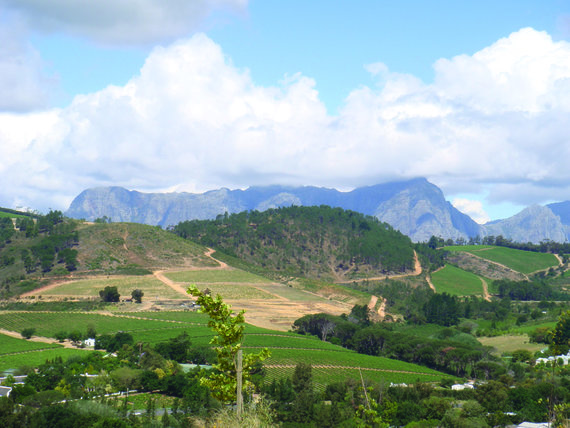“In my view Chenin Blanc is about to surpass Sauvignon Blanc as the leading white variety and the width of Chenin expression from bush vine, dry land, sparkling, MCC, barrel fermented, and natural sweet on offer should emphasise SA as the only other real world player in Chenin Banc next to the Loire.
“Ironically the ageing SA vineyards have opened another niche offer, with many special old vine blocks being identified and sold as single offers.
“Grapes to watch therefore are Chenin Blanc, Cinsault, Grenache Blanc, Malbec and sexy premium white blends. The clever people are planting unusual stuff for SA such as Tempranillo, Malbec and Grenache and even a number of exotic varieties found in Europe. And Chardonnay and Cabernet Sauvignon, as the biggest losers in vineyard space, should not be forgotten as an opportunity when supply shortens and prices shoot up,” says Van der Watt.
KWV chief winemaker Wim Truter says: “We have a strong focus on Petit Verdot and Grenache Blanc but we are also excited about Malbec, Cabernet Franc, Semillon and Tempranillo.
“Alongside the new varieties there is a growing focus on preserving our amazing old vines as well as shining the light on the traditional back-bone of the industry – Cinsault. It is an amazing grape with the potential to become a signature grape for South Africa.”
Jordan says Chardonnay and Bordeaux blends should not be forgotten. Interestingly he plumps for a Greek variety, Assyrtiko.
He says: “Global warming/climate change has also meant we have been looking at new varieties better suited to our changing climate. Greek varieties such as Assyrtiko seem interesting from an acid retention and lower water requirement point of view and, in fact, assyrtiko.com points to Jordan Wine Estate.”
Oldenburg’s Costandius also chooses Assyrtiko, along with Albariño, and believes there is renewed interest in Cinsault and Grenache. Stellenbosch winemaker David Finlayson from Edgebaston, also lists Assyrtiko as a tip for the top.
Boutinot’s SA product manager Robin Naylor lists: “The Rhône – Mourvèdre, Grenache Blanc, Roussanne for planting. Whereas Cinsault & Semillon that have been here for so long are now being locally championed at last.”
Lynne Sherriff MW, of ABS Wine Agencies, says Semillon and Cinsault are being rediscovered while Chenin Blanc and Pinotage are uniquely South African varietals that are starting to be appreciated for what they can offer.
She also points to Bordeaux blends and Rhone-style blends, both red as growing in popularity.
REGIONS
Regions such as Stellenbosch, Paarl, Franschhoek, Elgin, Robertson, are widely regarded as SA’s premier wine-producing regions. Sheriff believes Swartland should be up there as well, as she feel this is one of SA’s most exciting and dynamic regions. She would also include Elim and Cederberg.
Jack suggests: “New regions are popping up all the time. For elegance head to the Overberg.” Apart from, obviously, Constantia, Astrom backs Elgin, Hemmel an Arde and Greyton.
Bureau says: “I think the big trend is towards cooler areas, and Elim seems to come up quite often.”
“An area in Paarl to watch is Agter-Paarl, which is unique enough to establish its own ward. You will see more of these terroir-driven demarcations in future,” says Van der Watt.
Distell chief winemaker Razvan Macici, who was cellarmaster at Nederburg from 2001 to 2015, says: “Climate change is certainly a challenge. Many South African producers, including Nederburg, are introducing Mediterranean varieties better able to withstand drier and warmer conditions, and so far, the results have actually been very exciting.”
Macici continues: “New wine-growing areas are being developed, along the coast, further inland, like high up in the Matroosberg pass where Nederburg has vineyards and in the southern Cape.”
SUMMARY
In summary Bureau says: We need ‘icon wines’ to come through the woodwork, but they are not created overnight. I am confident that a growing awareness of our wines, and a more global trading place, will facilitate this and speed it up.”
Edgebaston’s Finlayson is pessimistic. “I don’t see it changing much from where it is due to the markets not wanting it to change.
“We are still seen as a producer of lots of cheap and cheerful Chenin Blanc and red blends while there is a small pinnacle of world-beating top quality wine that unfortunately will never be bought by many people who still stick to France, Italy and Spain just because they feel safe buying from those countries, even if the quality doesn’t match South Africa’s top wines.”
Bruce Jack concludes: “Stylistically, South Africa is like Picasso. We are emotionally moved. Styles change continuously. Experimentation is embraced everywhere. The artistic side of winemaking is celebrated, even in the most corporate environments. Nowhere in the world are things so eclectic, exuberant and interesting when it comes to style.”




